|
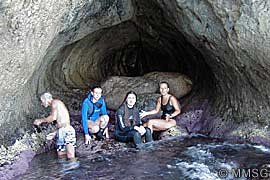 |
|
|
MMS Group researchers at Palagruza. From left to right, Pave Fadic, Adriana Borcic, Marta Blazevic and Jasna Antolovic.
|
|
Members of Croatia’s Mediterranean Monk Seal Group (Grupa Sredozemna Medvjedica) undertook field expeditions in the Vis archipelago during the May-September period. The islands in the archipelago comprise Vis, Bisevo, Svetac, Palaguza and Susac. Former and potential habitat was checked for any trace of monk seal presence, but none was detected, despite several recent sightings reports. Three new caves were found during the survey that appear promising as monk seal habitat, one on the south coast of Vis and two on Palagruza.
During the same period, three exhibitions were held under the banner “The Sea is Alive”, as well as a workshop for kindergarten and school children. Numerous educational lectures promoting marine conservation awareness and the protection of the monk seal were also held. – Jasna Antolovic, MMS Group.
Season’s recruits
The first monk seal birth of the new pupping season was recorded by MOm researchers in August. The newborn pup was observed with its mother in a cave on the island of Piperi, in the strictly protected core zone of the National Marine Park of Alonissos-N. Sporades. To date, four additional newborn pups have been recorded in the Park.
Further south on the island of Kimolos in the Cyclades archipelago, MOm is striving to establish a second marine park, based on experience gained through eleven years’ work in the N. Sporades. The first newborn pup of the season was recorded on 8 September by the field team established by MOm to monitor the seal population as part of the EU LIFE-Nature programme. The biologist responsible for research in the area, Katerina Anagnostopoulou, reports that four more pups have been recorded to date. Since the breeding season is still in progress, we expect more good news from both areas. – Panos Dendrinos, MOm.
Greek-Turkish liaison
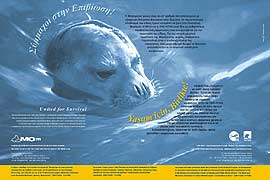 |
|
|
|
A joint MOm-SAD/AFAG poster marks a new-found Greek-Turkish cooperation in monk seal research and conservation
|
|
|
In an initiative funded by the Greek Ministry of Environment [the Bilateral Development Cooperation and Assistance Programme], MOm has embarked on a cooperative venture with its Turkish counterpart, the Underwater Research Society-Mediterranean Seal Research Group (SAD-AFAG). The two organisations plan to learn from each other’s experiences in science, conservation and management through project exchange visits, and share information on monk seal sightings. The project was formally announced on World Environment Day (5 June) during the inauguration of the National Centre for the Environment and Sustainable Development in Athens. In July, a 6-strong SAD-AFAG team made its way to Alonissos for an introduction to monk seal conservation activities in the Northern Sporades Marine Park. MOm biologists and staff members made their reciprocal trip to Turkey in September, visiting the Foça Specially Protected Area and the Karaburun Peninsula. – Kalliopi Gorgorapti, MOm.
Bones galore at Gerakas
|
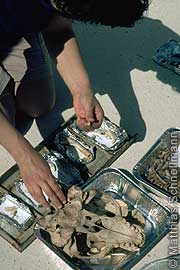 |
|
|
Sorting monk seal bones at Gerakas
|
|
During mid-May a team assembled by MOm at the Gerakas Research Station on Alonissos set about cleaning and cataloguing an array of monk seal bones and complete skeletons that the organisation has collected during the last decade.
Analysis of the bone samples allows valuable information to be gleaned on various aspects of the species’ biology, including its evolution and genetic potential, morphological and nutritional data, and longevity.
Because of the scarcity of Mediterranean monk seals and their elusive nature, biological samples of the species are rare. However, from autopsies carried out in various parts of Greece during the past decade, MOm researchers have collected bone samples or entire skeletons from 34 different monk seals. – Eugenia Androukaki, MOm.
Uncertain causes
MOm’s Rescue Team carried out several necropsies during the spring and summer on monk seals found dead in the Aegean and the Ionian Seas.
Two young female seals were discovered dead in April and May respectively on the island of Kefallonia and in N. Aghialos, Volos. Determination of the cause of death in both cases was not possible due to the animals’ advanced state of decomposition. An analysis of necropsy results from 2000, however, reveals that deliberate killing still represents the single greatest cause of mortality in monk seals in Greece.
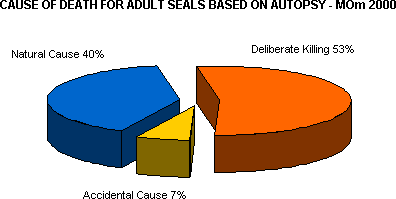
A third casualty, a weaned female newborn seal, was found dead in May on the island of Kimolos, the prospective marine park that is already designated a Natura 2000 site. Called to the area, MOm’s Rescue Team determined that the seal was young, about 6 months old, and in an advanced state of decomposition. Although biopsy analysis did not allow determination of the cause of death, local residents claimed that the seal had died due to entanglement in fishing nets.
Two additional seals were found dead on beaches at Mandoudi on the island of Evia and at Keratea in Attica, in June. These were also young female seals caught in fishing nets. Necropsy samples were taken to confirm the initial diagnosis for both animals of death due to suffocation. Drowning due to entrapment in fishing nets constitutes one of the most significant causes of death for young Mediterranean monk seals. – Eugenia Androukaki, MOm.
LIFE funding for Natura 2000 areas
Earlier this year, MOm was granted EU funding for the cornerstone of its conservation strategy in the Aegean – the establishment of Natura 2000 protected areas for the monk seal at the islands of Kimolos-Polyaigos in the Cyclades, and Karpathos-Saria in the Dodecanese [see TMG, passim].
In recognition of its efforts, the EU General Directorate for the Environment’s LIFE-Nature programme awarded MOm almost 900,000 euros, or 60% of project requirements. Following standard procedure, the remainder of the 1.5 million budget is expected to come from other sources acquired by the organisation or provided by its supporters. The programme, entitled The Mediterranean seal: Conservation actions in two Greek NATURA 2000 sites, will run for four years (January 2001 – February 2005), and is supported by the Ministry of Environment and the Prefecture of the Cyclades. A proportion of the additional funding required to meet some of the programme’s budget shortfall will, it is understood, be provided by these official bodies.
The primary objective in both areas is the conservation of monk seals and their habitat through the implementation of specific management actions that are designed to counter identified threats while encouraging the participation of local stakeholders. Indeed, the management actions at both NATURA 2000 sites, based on already completed Special Environmental Studies [see Natura 2000 areas continue to attract support, TMG 3(1): May 2000] are tailored to the unique socio-economic conditions prevailing at each site.
Reflecting the renewed impetus that EU support has afforded the programme, MOm has recently established a permanent presence on both island complexes in an effort to maintain effective communication with local government and stakeholders.
Other priorities listed in the LIFE-Nature programme include ongoing monitoring in monk seal habitat and educational and public awareness activities. As part of its aims in this sector, on 15 June this year MOm established an Information Centre in the old Customs House at Diafani, N. Karpathos, generously provided by the Local Community of Olympos.
Based on its decade-long experience of guarding the National Marine Park in the Northern Sporades [see All at Sea, this issue and Guarding continues in the Sporades, TMG 4(1): May 2001] MOm also intends to establish a trial guarding project in both the Kimolos and Karpathos areas, using locally-recruited guards who would undergo special training, and fast, well-equipped speedboats. – Stella Adamantopoulou, MOm.
‘Terrorist attack’ on Zakynthos Marine Park
The National Marine Park of Zakynthos, established in 1999, was hit by a string of arson attacks in mid-October. The area, whose protection has been a contentious issue for almost a quarter of a century, was created primarily to protect nesting sites of the critically endangered marine turtle, Caretta caretta, although some of Zakynthos’ last monk seals are also known to venture into the area. Die-hard elements within the tourism and development sectors, however, have always vigorously opposed efforts to establish the Park. According to the Environment Ministry and WWF Greece, the attacks – in which fires were apparently set on four separate fronts – were timed to coincide with the Council of State’s rejection of appeals against the Park’s framing Presidential Decree. Firemen, backed up by two planes and two helicopters, fought the wind-fanned blaze that eventually destroyed extensive sections of forest near turtle nesting beaches before being brought under control. A spokesman for the Environment Ministry called the fires "terrorist attacks on nature."
Breeding at Deserta Grande
|
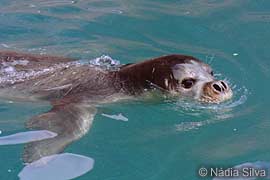 |
|
|
A juvenile seal at the Desertas Islands
|
|
Monk seal research continued in the Desertas Islands strictly protected reserve during summer. In the southwest of Deserta Grande – the main reproduction area – regular observations were made of a group of 5 (non-identified) individuals, one of which was a pup probably born in May outside of the typical reproductive season. Observations suggest that there are now two different monk seal groups using the same area in different seasons to reproduce. – Rosa Pires, Parque Natural da Madeira.
Madeira island observations
Sporadic observations of monk seals continue to be reported by the public from around Madeira, reinforcing the belief among researchers that the species might be in the process of recolonising the main island, where it was previously considered eradicated [see Are monk seals recolonising Madeira island? TMG 4(1): May 2001]. Of particular significance were the multiple sightings during one week in August – presumably of a single seal – by numerous people in bathing complexes along the south coast, from Santa Cruz to Funchal. Reflecting the rarity of the event, Madeira’s local press gave it high prominence in its reporting. – Rosa Pires, Parque Natural da Madeira.
|



